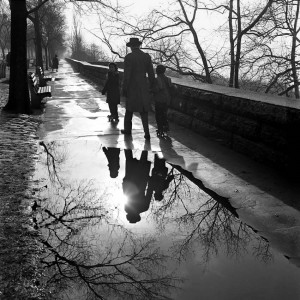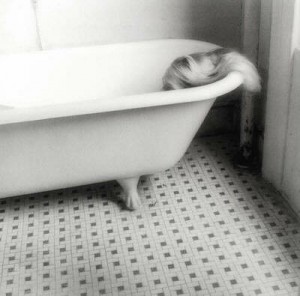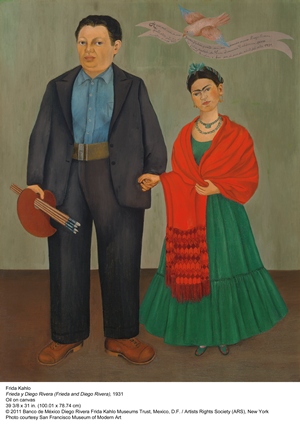 I got a look at LACMA’s new surrealism show this week. In Wonderland: The Surrealist Adventures of Women Artists in Mexico and the United States, which opens on Sunday (1/29) and runs until early May, is significant for being the first show to survey North American, women surrealists. Wandering the galleries, with hordes of other eager (mostly women) art-lovers, I was struck by the essential struggle of any woman artist. See how, in her self-portrait with husband Diego Rivera, Frida makes herself small, dwarfed by the “more important” artist?
I got a look at LACMA’s new surrealism show this week. In Wonderland: The Surrealist Adventures of Women Artists in Mexico and the United States, which opens on Sunday (1/29) and runs until early May, is significant for being the first show to survey North American, women surrealists. Wandering the galleries, with hordes of other eager (mostly women) art-lovers, I was struck by the essential struggle of any woman artist. See how, in her self-portrait with husband Diego Rivera, Frida makes herself small, dwarfed by the “more important” artist?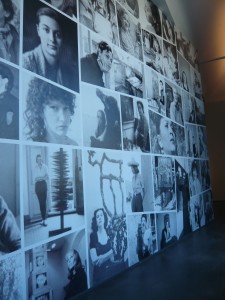
In one corner of the exhibit, I sat below wall-size images of all the artists and read short biographies of each of them, quickly realizing that most had eschewed the traditional role of motherhood and explored their dreams and circumstances through surrealism. There were well-known women, such as the beautiful Lee Miller, who was first a model and then a muse to Man Ray, who lived and worked amongst the male surrealists and eventually became the wife of Roland Penrose. There were artists that I’d never heard of, and there was the uninimitable Frida; the paintings on display are magnificent – pained and luxurious and worth the price of admission all on their own. 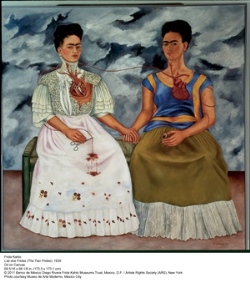 Digging deeper through the works of the 47 women, I fell under the spell of several artists new to me (including Deborah Tanner and Helen Lundeberg), reflected on the bridge between these surrealist rebels and the soon-to-follow awakening of the feminist movement, and fell in love with an artist I’d never known before: Francesca Woodman. Woodman, who committed suicide at 22, was a bridge between these early pioneers and contemporary photography, taking up the tropes of the earlier women but translating it to modernity in the 1970s. Her simple black and white photography, done while she was an art student at RISD and during a trip to Italy, expresses her dreams and sexuality in a way that’s easy to understand today, and helped me to understand the tropes explored by the earlier artists.
Digging deeper through the works of the 47 women, I fell under the spell of several artists new to me (including Deborah Tanner and Helen Lundeberg), reflected on the bridge between these surrealist rebels and the soon-to-follow awakening of the feminist movement, and fell in love with an artist I’d never known before: Francesca Woodman. Woodman, who committed suicide at 22, was a bridge between these early pioneers and contemporary photography, taking up the tropes of the earlier women but translating it to modernity in the 1970s. Her simple black and white photography, done while she was an art student at RISD and during a trip to Italy, expresses her dreams and sexuality in a way that’s easy to understand today, and helped me to understand the tropes explored by the earlier artists.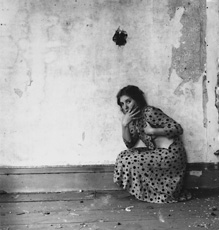
After visiting the surrealism show – which I recommend for teens and perhaps groups of women to explore together-– I saw the work of a photographer named Vivian Meier.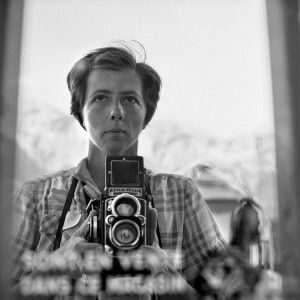 Please click over to my short piece about her work, mostly street photography conducted while she was a nanny in Chicago in the 1950s. Maier also eschewed traditional roles – no marriage and no children, other than the ones she was paid to care for — and with that freedom, managed to create remarkably humane and elegant photographs.
Please click over to my short piece about her work, mostly street photography conducted while she was a nanny in Chicago in the 1950s. Maier also eschewed traditional roles – no marriage and no children, other than the ones she was paid to care for — and with that freedom, managed to create remarkably humane and elegant photographs.
Photography touches me directly, and so I have added these two images to my “imaginary photo collection,” the bathtub image from Woodman and the family walking from Maier.

